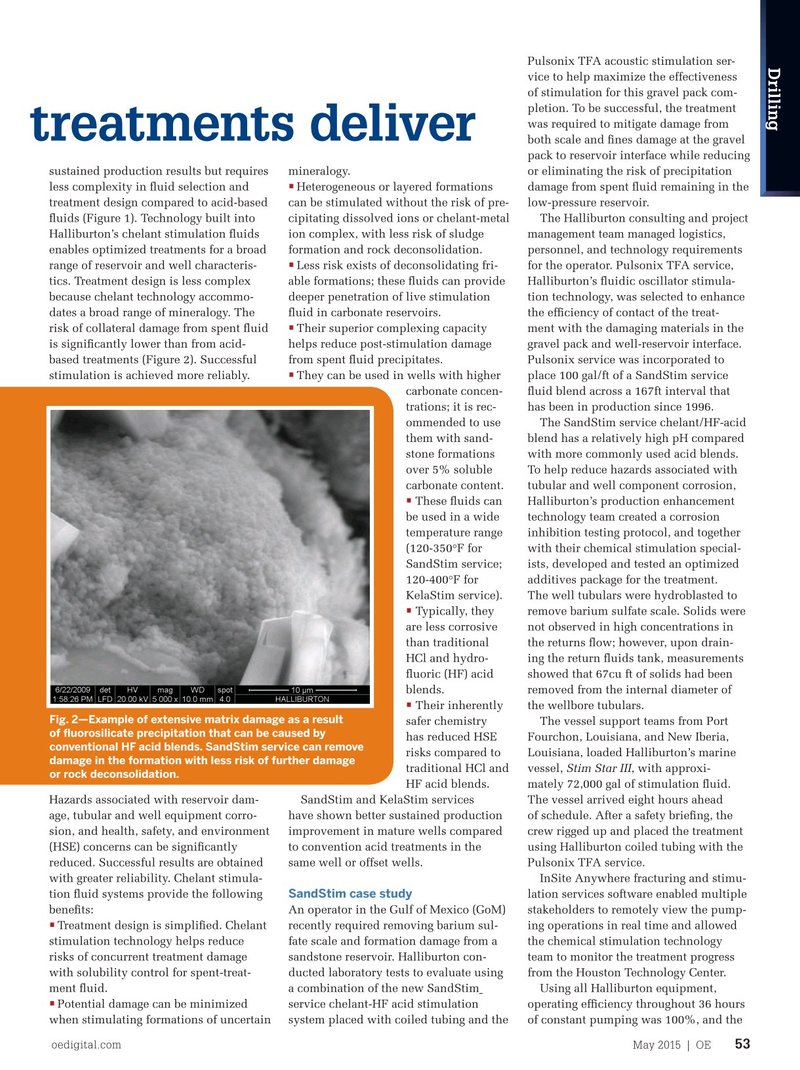
Page 51: of Offshore Engineer Magazine (May/Jun 2015)
Read this page in Pdf, Flash or Html5 edition of May/Jun 2015 Offshore Engineer Magazine
Pulsonix TFA acoustic stimulation ser-
Drilling vice to help maximize the effectiveness of stimulation for this gravel pack com- pletion. To be successful, the treatment was required to mitigate damage from
Improved chelant stimulation treatments deliver both scale and fnes damage at the gravel pack to reservoir interface while reducing sustained production results but requires mineralogy. or eliminating the risk of precipitation • less complexity in fuid selection and Heterogeneous or layered formations damage from spent fuid remaining in the sustained production gains treatment design compared to acid-based can be stimulated without the risk of pre- low-pressure reservoir.
fuids (Figure 1). Technology built into cipitating dissolved ions or chelant-metal The Halliburton consulting and project metallurgies can contribute to unaccept- Halliburton’s chelant stimulation fuids ion complex, with less risk of sludge management team managed logistics, able corrosion rates with conventional enables optimized treatments for a broad formation and rock deconsolidation. personnel, and technology requirements • acid stimulation fuids. In this type of range of reservoir and well characteris- Less risk exists of deconsolidating fri- for the operator. Pulsonix TFA service, well, conventional hydrochloric- (HCl-) tics. Treatment design is less complex able formations; these fuids can provide Halliburton’s fuidic oscillator stimula- based or organic acid stimulation fuid because chelant technology accommo- deeper penetration of live stimulation tion technology, was selected to enhance treatments can provide a potential for dates a broad range of mineralogy. The fuid in carbonate reservoirs. the effciency of contact of the treat- • gain but that might not outweigh the risk risk of collateral damage from spent fuid Their superior complexing capacity ment with the damaging materials in the of a lost well or the cost of an unpredict- is signifcantly lower than from acid- helps reduce post-stimulation damage gravel pack and well-reservoir interface. able result. based treatments (Figure 2). Successful from spent fuid precipitates. Pulsonix service was incorporated to •
Fortunately, new chemical stimula- stimulation is achieved more reliably. They can be used in wells with higher place 100 gal/ft of a SandStim service carbonate concen- fuid blend across a 167ft interval that trations; it is rec- has been in production since 1996.
ommended to use The SandStim service chelant/HF-acid them with sand- blend has a relatively high pH compared stone formations with more commonly used acid blends. over 5% soluble To help reduce hazards associated with carbonate content. tubular and well component corrosion, These fuids can Halliburton’s production enhancement • be used in a wide technology team created a corrosion temperature range inhibition testing protocol, and together (120-350°F for with their chemical stimulation special-
SandStim service; ists, developed and tested an optimized 120-400°F for additives package for the treatment.
KelaStim service). The well tubulars were hydroblasted to •
Typically, they remove barium sulfate scale. Solids were are less corrosive not observed in high concentrations in than traditional the returns fow; however, upon drain-
HCl and hydro- ing the return fuids tank, measurements fuoric (HF) acid showed that 67cu ft of solids had been blends. removed from the internal diameter of •
Their inherently the wellbore tubulars.
Fig. 2—Example of extensive matrix damage as a result safer chemistry The vessel support teams from Port of fuorosilicate precipitation that can be caused by has reduced HSE Fourchon, Louisiana, and New Iberia, conventional HF acid blends. SandStim service can remove risks compared to Louisiana, loaded Halliburton’s marine damage in the formation with less risk of further damage traditional HCl and vessel, Stim Star III, with approxi- or rock deconsolidation.
HF acid blends. mately 72,000 gal of stimulation fuid. tion technology advances offer better Hazards associated with reservoir dam- SandStim and KelaStim services The vessel arrived eight hours ahead alternatives for wells with mineralogy or age, tubular and well equipment corro- have shown better sustained production of schedule. After a safety briefng, the corrosion characteristics unsuitable for sion, and health, safety, and environment improvement in mature wells compared crew rigged up and placed the treatment acid stimulation and for wells with insuf- (HSE) concerns can be signifcantly to convention acid treatments in the using Halliburton coiled tubing with the fcient reservoir mineralogy information reduced. Successful results are obtained same well or offset wells. Pulsonix TFA service.
necessary to determine a reliable acid with greater reliability. Chelant stimula- InSite Anywhere fracturing and stimu-
SandStim case study stimulation treatment design. tion fuid systems provide the following lation services software enabled multiple benefts: An operator in the Gulf of Mexico (GoM) stakeholders to remotely view the pump-
Chemical stimulation technology •
Treatment design is simplifed. Chelant recently required removing barium sul- ing operations in real time and allowed
Chelant-based stimulation fuids from stimulation technology helps reduce fate scale and formation damage from a the chemical stimulation technology
Halliburton, such as SandStim for risks of concurrent treatment damage sandstone reservoir. Halliburton con- team to monitor the treatment progress sandstone reservoirs and KelaStim for with solubility control for spent-treat- ducted laboratory tests to evaluate using from the Houston Technology Center.
carbonate reservoirs, constitute the next ment fuid. a combination of the new SandStim Using all Halliburton equipment, • step in chemical stimulation. Chelant Potential damage can be minimized service chelant-HF acid stimulation operating effciency throughout 36 hours technology enables more reliable when stimulating formations of uncertain system placed with coiled tubing and the of constant pumping was 100%, and the oedigital.com May 2015 | OE 53 052_OE0515_D&C1_Halliburton.indd 53 4/20/15 3:18 PM

 50
50

 52
52